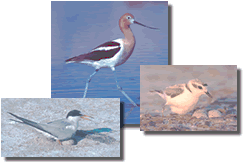


Salt Plains National Wildlife Refuge is one unit in a system of over 540 refuges scattered throughout the United States which provides nearly 95 million acres of wildlife/wildland habitat. The Salt Plains NWR was established in 1930 as a refuge and breeding ground for birds. It provides habitat for approximately 312 species of birds and 30 species of mammals. To maintain the purpose of the refuge, all activities on refuge lands and water are strictly controlled; please consult regulations.
The refuge is divided into almost equal parts of salt flats, open water, and vegetated land (marsh, woods, grasslands, and cropland). (Pictured to the left - FWS Photos)
Farming, grazing, prescribed burning, and wetland draining/flooding are management tools used to enhance the habitat for wildlife. Many ponds and marshes have been built to encourage the growth of wild millet, alkali bulrush, smartweed, and other moist soil plants that waterfowl use for food.
Moist-soil management on the marshes allows plants to grow and seed at optimum levels for waterfowl use. This kind of management requires calculated flooding and draining of the wetlands throughout the year. This imitates the natural rain cycle in a wetland to dry out while important seeds establish and then to fill for waterfowl habitat use.


Salt Plains, like many refuges, was created to be a rest-stop for migrating birds. Peak waterfowl populations at Salt Plains NWR during migration is 100,000 geese and 70,000 ducks. American White Pelicans migrate in mid-September with numbers ranging up around 40,000.
The refuge is also a stop-over point for Sandhill Cranes, the endangered Whooping Cranes and Bald Eagles. The peak population of Bald Eagles during migrations is 25-30 eagles.
Other avian migrants using the Salt Plains NWR include gulls, raptors, herons, egrets and ibis.
The salt plains are a unique geological area. The 11,000-acre barren area is nearly flat (actually has a slope of 4 to 8 ft towards the reservoir) with a wafer thin salt crust. The salt was formed by repeated flooding by sea water millions of years ago. The sea water was cut off from the sea and evaporated, depositing thick layers of salt.
The area was subsequently covered by erosion from mountain ranges. Below the plains, ground water travels through the salt-saturated sand and comes to the surface where it evaporates, leaving the crust of salt. The concentrated saline solution combines with gypsum to promote selenite crystal growth in a portion of the salt flats.

The salt flats may be devoid of vegetation but not of wildlife. The area is a major nesting site for the endangered interior least tern, the threatened western snowy plover, and the American avocet. (Pictured to the right - FWS Photos).
The flats are also a major migration rest area for hundreds of thousands of shorebirds during spring, summer, and fall. While vegetation on the flats is sparse, they feed on the salt brine flies that hatch when water is available.
Managing land for wildlife is a complex task. Salt Plains National Wildlife Refuge must be carefully protected and managed to provide the best habitat for a broad array of wildlife. A habitat is a home that provides the necessities - food, water, shelter and space for the animals. The loss of habitat has been detrimental to many wildlife species and the U.S. National Wildlife Refuge system seeks to provide ample habitat to support wildlife in America.
Salt Plains National Wildlife Refuge has been designated as an Important Bird Area and a part of the Western Hemisphere Shorebird Reserve Network. The entire refuge has been designated critical habitat for the endangered whooping crane.